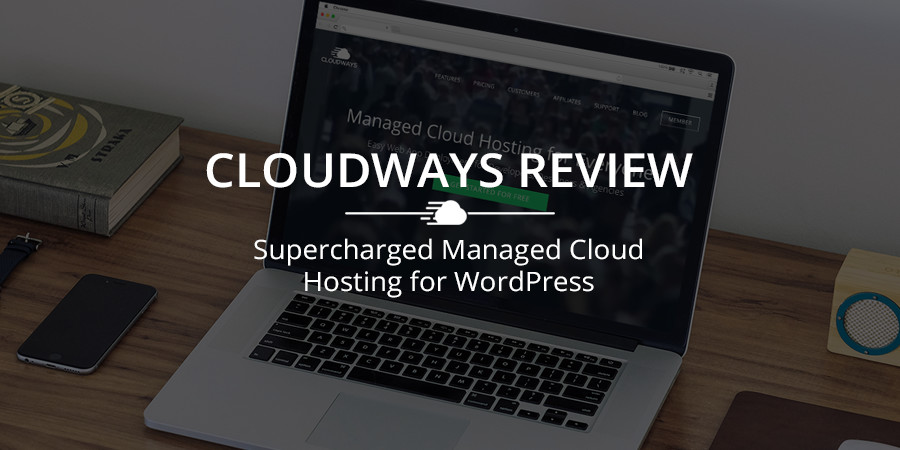
Cloudways Cloud Hosting
There are literally hundreds of hosting options on the web, each with tons of different hosting options. Shared hosting. Managed WordPress hosting. VPS. Dedicated server. And of course there is cloud hosting. When you search for managed cloud hosting Cloudways is one of the first to appear, and with good reason. Since their inception in 2011 Cloudways has provided one of the top managed cloud hosting services and today we wanted to show you what they’re all about.
About Cloudways Managed Cloud Web Hosting
Cloudways is one of the top providers of cloud hosting. What is cloud hosting? It’s pretty much exactly what it sounds like – hosting via the “cloud.” Basically a huge number of real world servers work together as one system to provide a stable and secure hosting for virtual servers. This means higher performance at a lower cost with even greater web hosting flexibility.
What Makes Cloudways Different
Cloud hosting is available from a number of well-known hosting companies, but Cloudways has taken it to the next level. They’ve improved upon the traditional cloud to bring you several managed cloud hosting options with standout features.
First off they use the latest servers and systems (nginx, varnish, memcached and apache to be specific) as a part of what they call the ThunderStack. This incredible combo is what makes Cloudways hosting fast and reliable.
The other great part about Cloudways as opposed to some of their competitors is that they provide managed server-side security with all of their plans. They use multiple layers of protection with auto-updates to keep all of the servers on their platform up to date.
Plus you’ll be hard pressed to find another host that allows you the variety of platform choices (your pick of DigitalOcean, VULTR, Amazon or Google), unlimited installations, team collaboration, easy server scaling and an amazingly easy to use account console (which you’ll see plenty of snapshots of later) and free SSL certificates via Let’s Encrypt.
Cloudways Cloud Hosting Plans
Now that you know what it is Cloudways does you should have a look at their plans. One of the best features of Cloudways is that they offer a variety of hosting options to suite any website’s budget or data needs.
You can choose from cloud servers starting as low as $10 per month, contact them for a custom built plan or choose one of the other server plans in the middle. All of their plans allow you to add as many website installations as you like, so if you’re a developer you can easily create a number of staging sites for clients without a hitch. And if you’re not a developer and just want to move your blog to Cloudways you’ll be happy to know that they’ll even help you migrate one site to your new server for free.
Cloudways WordPress Hosting Guide
If Cloudways sounds like the right host for your website (or if you just want to get an inside look at what their hosting has to offer) then our setup guide is the perfect next step. will walk you through the steps of getting your cloud server setup with Cloudways. Are you ready?
Signup For A Free Cloudways Account
To get started go to the Cloudways homepage click on the link to start your free trial. You’ll be taken to the main Cloudways signup page. You can choose to login with your LinkedIn or Github account but we prefer to sign in the old fashioned way with email.
Simply enter your email address and a password. You should then get an activation email in a few minutes.
Should you see an error that you’re “Almost There” don’t worry. Simply open up that 24/7 customer support chat box in the lower right corner of your screen. A Cloudways support tech will be more than happy to help. When we were setting up our test account this actually happened to us and the tech verified us and had an activation email sent in just a couple minutes. Now that’s awesome support (thanks again S. Rafat)!
Once you receive your activation email click on the giant green button to activate your account now.
Setup Your Cloudways Hosting Server
Now It’s time to get started actually setting up your server to host your website (or websites).
First you’ll select your application. Cloudways knows that WordPress is one of the most popular web platforms around so they’ve conveniently put it right at the top. There are three options to choose from:
- Standard WordPress
- WordPress Plus WooCommerce
- WordPress Multisite
Choose the option that fits your needs. If you’re not sure just go with standard WordPress. It’s easy enough to add WooCommerce later on or enable multisite (we have a guide for enabling WordPress multisite if you need some help).
Once you’ve selected your application add your own custom names for the app, server and your project. This is for your eyes only so pick something that will help you remember which website you’re setting this up for.
After making your app selection you’ll see available options for your cloud provider, server size and datacenter locations. The available provider options currently include:
- Digital Ocean: SSD based storage with 7 datacenters in 3 countries, plus a 14 day free trial
- VULTR: SSD based storage with 13 datacenters worldwide and a 3 day free trial
- Amazon EC2: configurable disk size, 8 datacenters in 6 countries and a 3 day free trial
- Google Cloud: 4 locations in 3 continents, designed specifically for large businesses or resource intensive websites with a 3 day free trial
If selecting Digital Ocean or VULTR it’s important to note that the lowest plan options from both are intended for staging or low traffic websites so Cloudways recommends you start with the 1G server size (although we see no problem with starting on the lowest plan and scaling up to the 1G plan later on). You can still successfully run a simple WordPress site on these plans, however if traffic increases or if you install a large plugin like WooCommerce you may encounter website or database crashes.
All four providers offer similar services with the biggest difference being price and reliability. Digital Ocean and VULTR both offer nearly unlimited bandwidth for your sites at a lower cost, making them great options for developers on a budget. Amazon & Google on the other hand provide bandwidth on a pay-as-you-go basis, meaning your monthly charges will likely be higher but you get the piece of mind that your site will never be throttled since you’re paying for every resource you use.
When it comes to choosing a server size do your best to pick the plan you estimate will meet your needs. If you’re not sure with to choose go with a standard plan – you can always add more resources to your server at a later time as needed. Cloudways makes it easy to upgrade your server plan at any point in time right from your server console (which we’ll show you later).
Once you’ve set you provider and server size the last step is to select a server location. We recommend choosing a server close to your main audience. So if most of your traffic comes from the USA then choose a server location in that country.
With that done you’re ready to launch your server! You should be taken to your console where you will see an estimated wait time for your server to be setup (our estimate was 7 minutes, and for us installation took approximately 10 minutes – pretty close!). While waiting you can complete your profile which asks for a contact number,plus optional information about your job and monthly spending on hosting.
Once your server setup is complete you can move forward to managing it. Click on your primed server to open up the console.
Managing Your Cloudways Server
The first time you open your Cloudways server console it will have a walk though guide open to teach you about your server summary, navigation bar, available actions and details.
By default your console will be open to your Master Credentials. From here you can edit your username and password, manage SSH keys, and view your IP address.
Next up is the Monitoring tab. There are a ton of different graphs and options for monitoring your server and applications, however there are two key server options to keep an eye on. The first is your Idle CPU (which should be the graph displayed by default). You can see in our graph that the server is mostly in the 95-100% range of free CPU which means there is plenty of room for our website to operate at the moment. If the graph was reversed and there were a significant number of instances where our free CPU was at 0% then it would be time to scale up to a larger server plan.
The other monitoring graph to check is your Free Memory. Small server plans can operate perfectly fine with just 15-50MB of free memory, but if your business has purchased a plan with 4GB or more your free memory should consistently be above 100MB. If it’s not this could be another sign that it’s time to scale up your plan.
After Monitoring you’ll see a Manage Services tab where you can see the various core Cloudways services that keep your server running. This includes Apache, caching, database and optional application monitoring (via New Relic) services. From here you can restart your various services as well as purge your cache.
Since you’re using WordPress you may need to adjust some of your server settings to be able to upload a specific file or install a large plugin or theme. All of these server settings and more can be found in the console Setting & Packages tab. Just be sure to save your changes.
Security if of the utmost importance for any website, and Cloudways help makes server security easy. Cloudways maintains firewalls and implements server patches regularly to hep keep your installations safe. They also monitor suspicious activity on your server. So if you have multiple failed login attempts because you forgot your password you could get locked out of your account. One way to prevent this is to edit the Security settings within your server manager to whitelist your own IP address. This is completely optional and most users can skip this section.
If you find that you need more server space you can easily increase your Cloudways plan at any time from the Vertical Scaling section. Just select the increased server size you need and click to apply your changes (which will be reflected in your next monthly charge).
Backups are also built into Cloudways server options and taken daily by default. From this tab you can enable backups to be taken as often as every hour or just once a week. You can also enable Local Backups which makes a copy of your most recent backup available for download vis SFTP/SSH so you can store your own backups on your computer.
Even though the included backups are great, we do still recommend using a service like VaultPress to ensure you have a complete copy of your website at your finger tips.
Lastly Cloudways does offer a couple of Addons that can be access via the server manager. To activate addons just click on the grid icon in the main menu.
There are four addons currently available, with the last two options adding configuration options to your server management section after activation:
- DNS Made Easy: Cloudways does not offer domain name system (DNS) to manage your domain names by default, instead they allow you to use your own third party DNS (like GoDaddy) or you can subscribe to their DNS Made Easy service. This addon starts at $2/month for up to 5 domains. This addon does require manual activation by Cloudways, so once enabled the addon will be set to pending until a support member can approve your change.
- Rackspace Email: To add an email service to your website you have the option of enabling the Cloudways Rackspace addon. This service is just $1/month per email. This addon also requires manual activation by the Cloudways tech support team, so when you activate the addon it will be pending until a support member contacts you to complete your mailbox setup.
- SMTP: This FREE Cloudways addon makes it possible for you to use a third party email service as a gateway to deliver emails from your server. Simply enable the addon, then navigate to your Server Management Add-Ons section to add and configure your email provider.
- Elastic Email: To send a high volume of monthly emails you might want to consider the Elastic Email addon since it provides a fast and easy way to contact your mainling list. Plans start at $0.10/month for 1000 emails (with discounts applied for higher volumes), and all you need to do is activate the addon and wait for the Cloudways support team to confirm that your subscription has been enable. This addon is also managed via the Server Management Add-Ons section.
Once you’ve throughly explored your Server settings and services you can move onto you Application settings!
Managing Your WordPress Installations
If you click on Applications in the main menu you’ll be take to your application manager. From here you can access all of your server installations (WordPress as well as any others you might have).
Simply click on one of your installed applications too see the related details and settings.
After clicking on one of your installations you’ll be taken to the Access Detail screen. This provides all of the basic information about your install like your temp URL, Admin login credentials for your site and MySQL information.
When you first get started with your Cloudways server your installations will be setup as staging sites on the main cloudwaysapps site. When you’re ready to move to a live site you’ll need to go to the Domain Management tab to add your URL (just remember to point your domain over).
SSL is becoming a more common feature for blogs and websites. This added layer tells visitors that the access their browser has to your server is encrypted so any information or data passed between them and you is safe. To add this security to your Cloudways hosted website simply go to the SSL Certificate section of your Application Manager and use the built-in tool to create a free SSL certificate from Let’s Encrypt. Simply add in the rested information and follow the onscreen prompts.
Alternatively you can toggle the SSL option to upload your own custom certificate. For this option you’ll need to create and download a Certificate Signing Request, create and purchase a SSL certificate via a third party service, then install it on your server.
The other two sections most users will want to note are the Migrator Tools and the Restore tab. Both of these are fairly self explanatory. When you first get started with Cloudways you can use their free migrator plugin to help move your website from your old host to your new Cloudways server (although your first assisted migration is free, so if you’re only moving one website you might was well let Cloudways handle it). Later on down the road, if something ever happens to your website and you want to restore it to the way it was simply go to the Restore tab. From here you can select a backup from the drop down and then click the button to upload.
If you’re a developer you might also be interested in a few more of the the built-in tools Cloudways has put at your finger tips. The Cron Job manager makes it easy to add scheduled tasks (like deleting temp files or sending our email notices) to your installation. There’s also a tab for Deployment via Git that makes it easy to generate your SSH key needed to connect to your repository, and an Application Settings tab with options for switching off Varnish caching while testing/staging. Plus for a fee they also offer a load test Application Add-On to see how you site performs with traffic.
Before moving on to your WordPress installation there are just a couple other options in the main Cloudways account console that we want to share with you.
Adding Team Members To A Cloudways Server
If you’re working with a team and on multiple projects then you’ll definitely want to take advantage of all the options the Team module has to offer. From here you can add your team, edit their access to specific servers or applications and restrict the operations with servers that they have access to (for example, it’s probably best that only the master admin has access to scale or delete servers).
Managing Projects With Cloudways
The last console section to have a look at is the Projects management page. from here you can see a quick snapshot of all your live projects. Just click on a project to view the related applications or to change the project name. This feature is mainly to help you keep all of your installations organized so you can see at a glance what belongs to which client, etc.
WordPress Quick Start Guide
Now that you’ve seen the most important options within your Cloudways console it’s time to move on to your actual WordPress site. Navigate back to your Application manager, click on the WordPress installation you’d like to work on and copy the Admin Panel username and password provided to you. Now click the link to go to your WordPress admin.
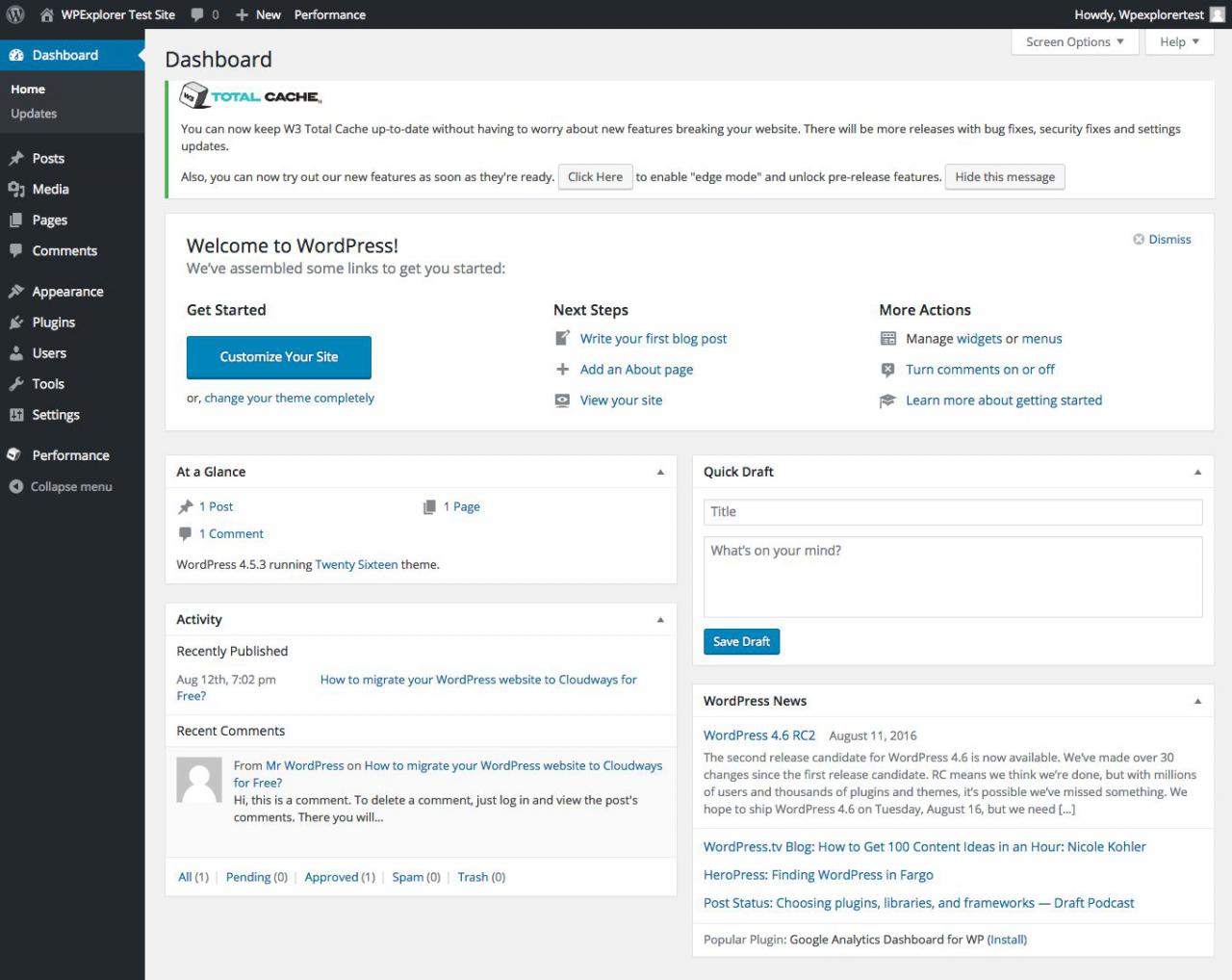
When you login for the first time with your credentials your dashboard should look something like the image above. Cloudways installs the latest version of WordPress as well as the W3 Total Cache plugin for you (note: if there is another caching plugin you’d rather use be sure to deactivate and delete W3 to prevent any plugin conflicts).
Your first priority should be to cleanup your install and get it ready for a theme and your content. Here are the first steps we recommend.
- Dismiss the message from W3 Total cache and then go to your Posts and Pages to delete the sample post and page already on your site.
- Navigate to Settings to edit your General site title and tagline, as well as your Permalinks(we recommend using the post name option) and remove the Writing option to notify Pingomatic of new posts (this last bit is optional though – you can leave it if you want to).
With our site cleaned up a bit now you can install your WordPress theme and any additional plugins you might want.
How To Install A WordPress Theme
Installing a theme is very easy with WordPress. All you need to do is navigate to Appearance > Themes and click on the button to Add New. From here you can browse free themes available from WordPress.org or you can click the button for Upload Theme to add your own WordPress theme.
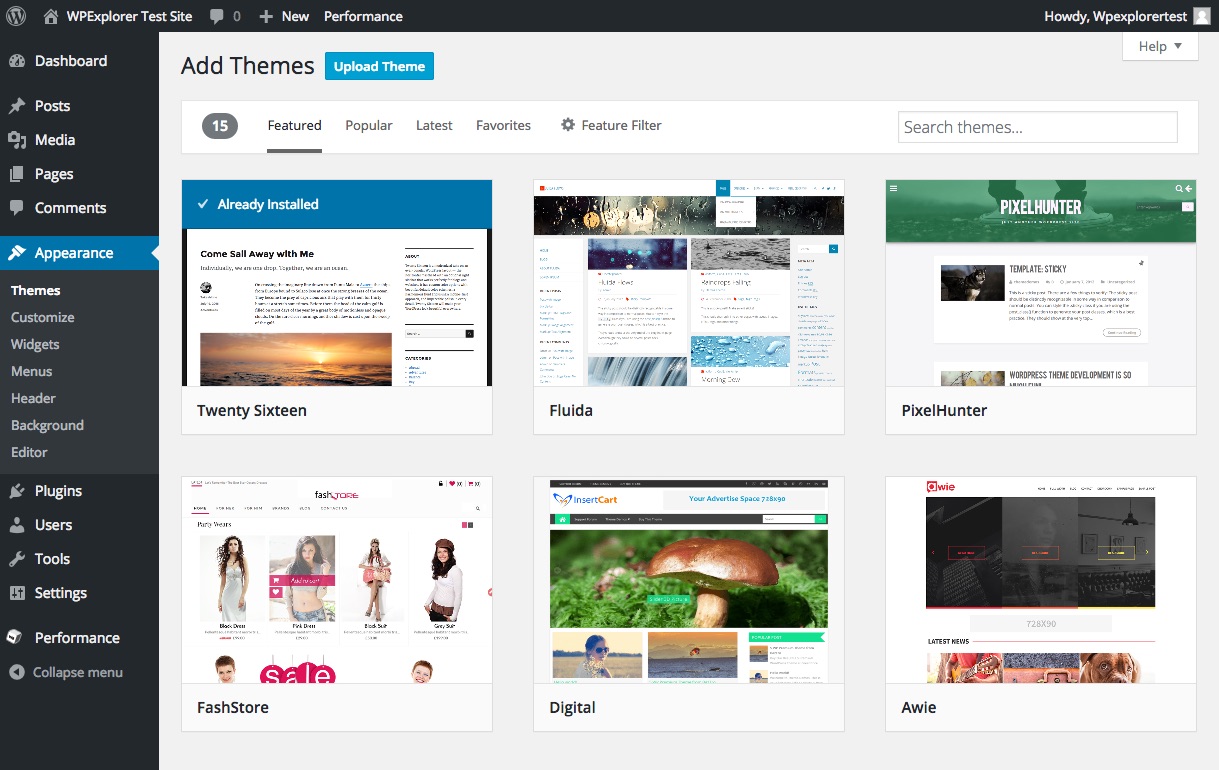
There are tons of great WordPress theme options on the web, and it can be a bit overwhelming when choosing a WordPress theme. Looking for a great Blog / Magazine theme? Good News is one of the popular ones that offers great flexibility and a very nice looking design. wprookies.com is actually using that theme!
Once you find a theme that you love (we love our Total multipurpose WordPress theme personally) you can install it. When you upload your theme the installable WordPress file should be in a .zip format.

Simply click the button to Choose File and browser for you theme zip, then click Install Now.

Depending on how large your theme file is you might see a 413 error like the one above. Don’t worry! This simply means that the file you tried to upload is larger than the max upload size you have your server is currently set to.
To fix this simply log back into your Cloudways Server Manager console and click on Setting & Packages. Bump up your file upload size to 35 MB and then click save.
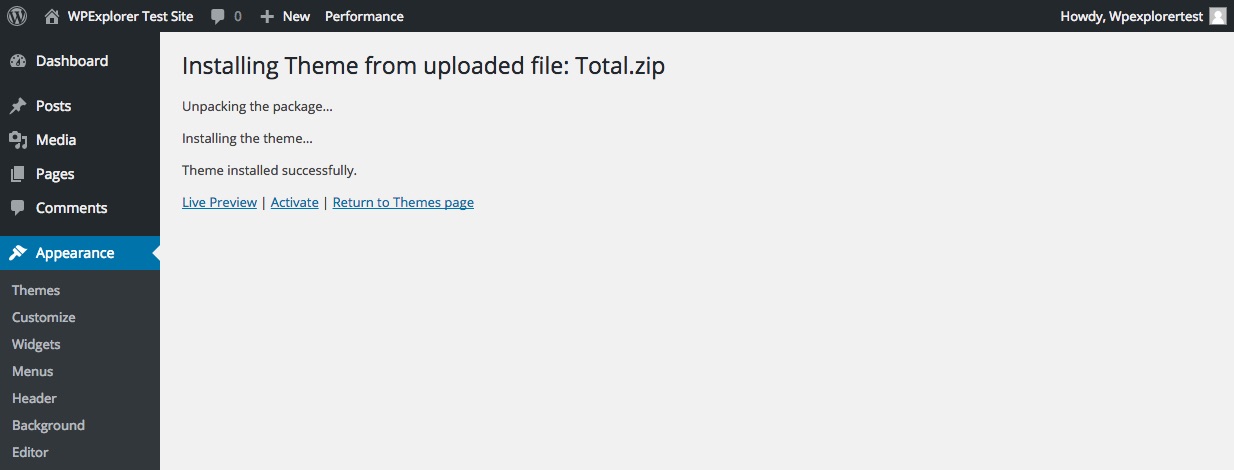
Now go back to your WordPress installation, re-upload the theme zip file and click Install Now. Everything should go smoothly and you should see the theme confirmation page like the one above. Just click to activate the theme! With a new theme in place you can start adding content or you could install a few handy WordPress plugins.
How To Install WordPress Plugins
WordPress plugins are installed much like WordPress themes and they can add a ton of great functions and features to your website.
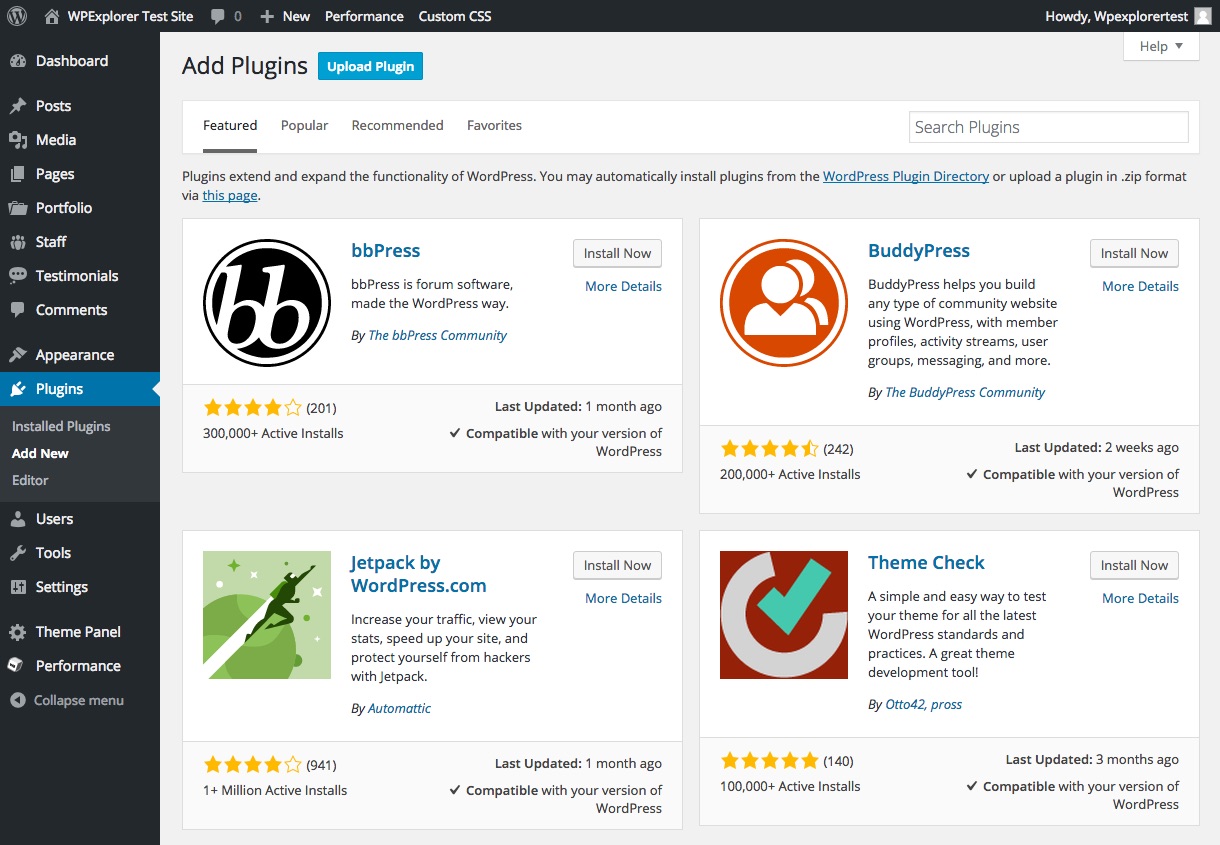
From your dashboard go to Plugins > Add New to browse all of the free plugins from WordPress.org. Just like themes there are plenty of free and premium plugins available around the web.
With your theme and plugins installed and activated you can start building your website. If your theme came with sample data you might want to upload that (just go to Tools > Import > WordPress to upload the sample .xml file that came with your theme). When uploading sample data your server might time out before it finishes. To avoid this simply uncheck the box to import media attachment files (you don’t want all those sample images mucking up your media library anyway).
You might want to also checkout the styling options for your theme and plugins under Appearance > Customize as well as any other options via a custom panel in your dashboard. Once you’ve got your website looking good you can start adding your content.
Blogging Tips
Depending on what your website is about there are tons of great tips on the internet for blogging, finding your own writing style, monetizing your blog and more.
Wrapping Up
Hopefully after reading through all the information above you have a better idea of what Cloudways has to offer WordPress users and how to actual get started with WordPress using Cloudways managed cloud hosting.
We were very impressed with their easy to use server console, quick WordPress setup and fast chat support. We give them a solid 5/5 as a host. Plus with tons of great built-in features for server scaling, SSL, teams and more Cloudways has positioned themselves as a great option for small businesses with one site as well as for design agencies that might be managing hundreds of client sites.
To learn more head over to the Cloudways website. You can get started with your own 14 day DigitalOcean trial (or 3 day trial for VULTR, Amazon or Google) simply by signing up with an email. No credit card required.
And if you have any questions about Cloudways WordPress cloud hosting, their features or our experience using it just leave us a question in the comments below. Or share you own Cloudways experience – we’d love to hear what you think!




















